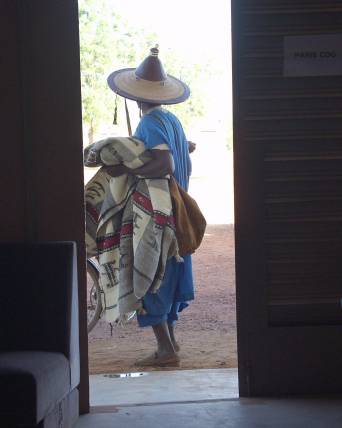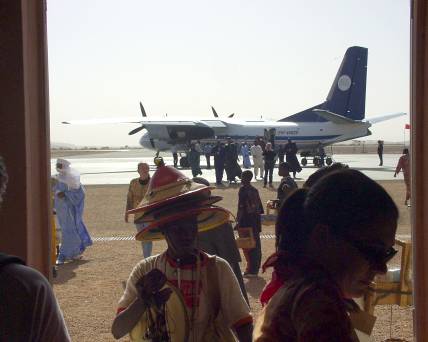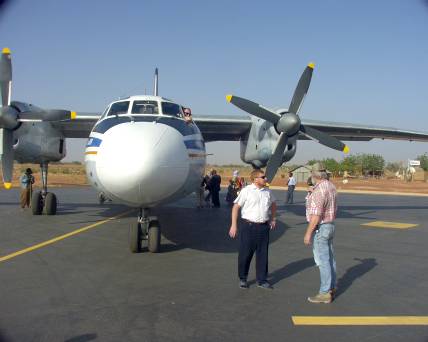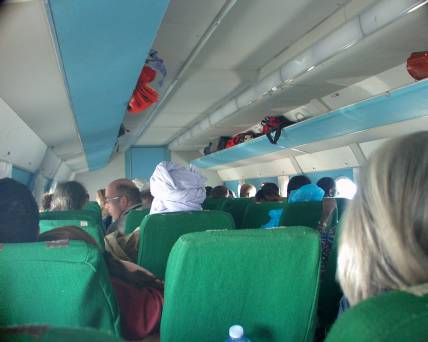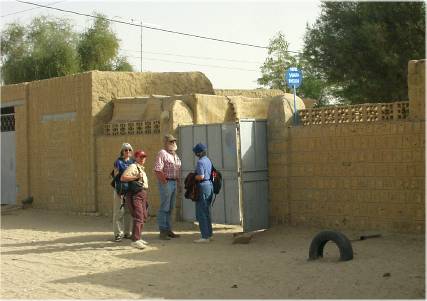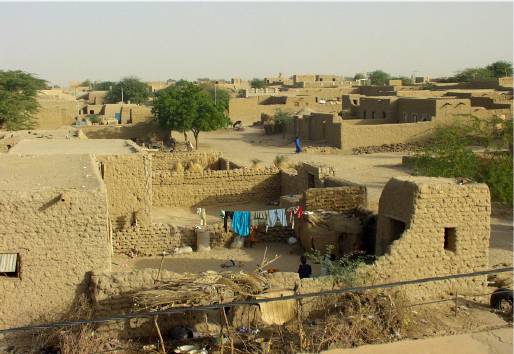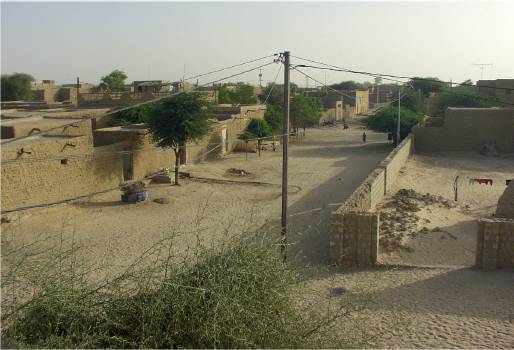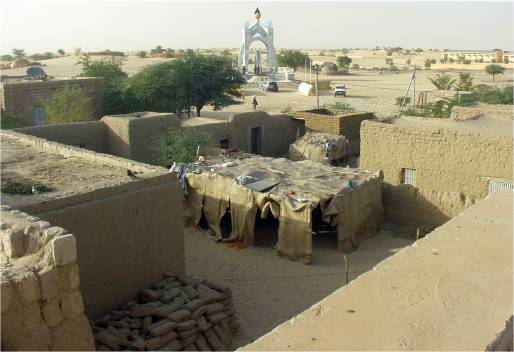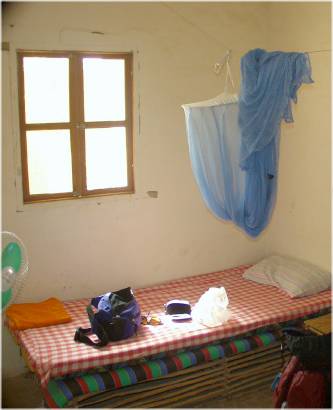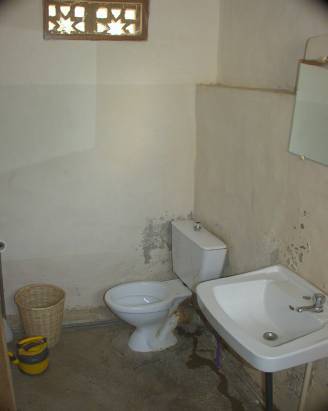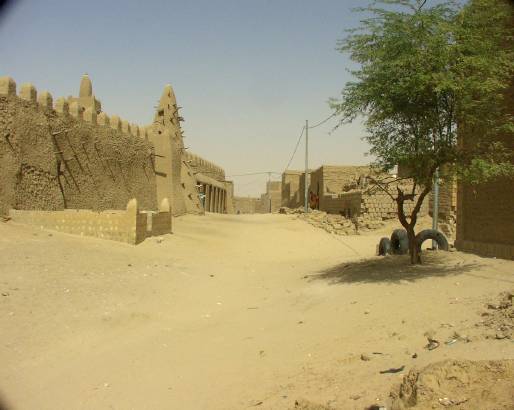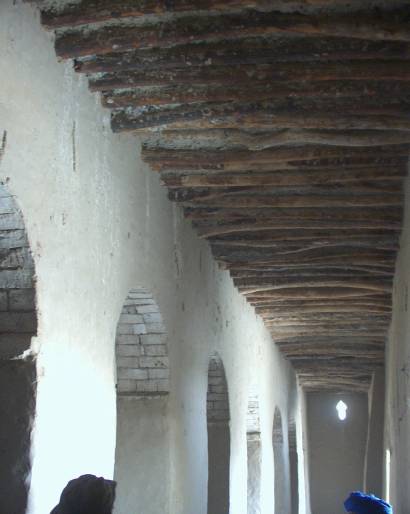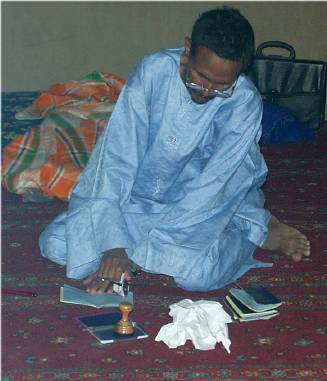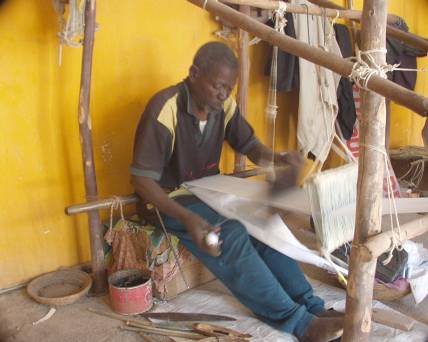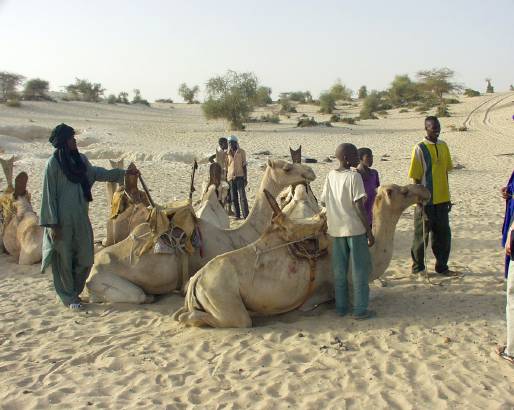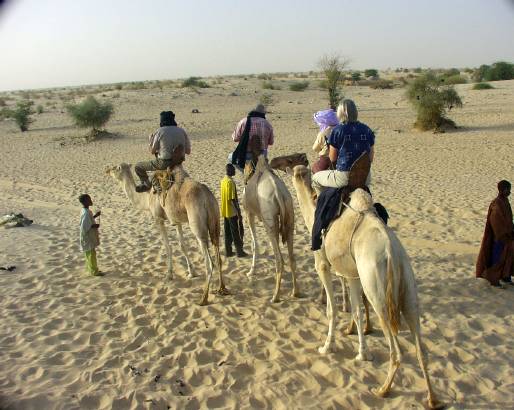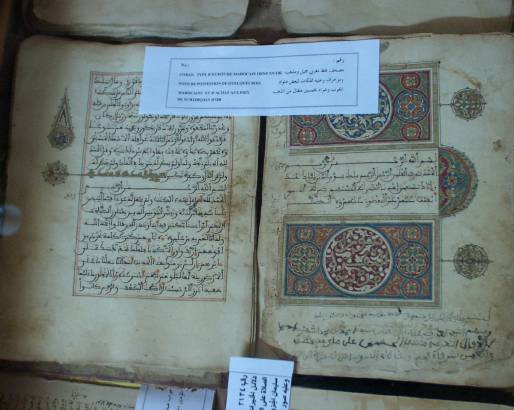Timbuktu (Tomboctou), Mali
Tomboctou, which is the spelling shown on most maps, is actually the
French
spelling (according to our guide), and the more familiar Timbuktu is
supposedly
closer to the true spelling. Timbuktu is in the middle of the
desert
and even the main streets of the city are sand (4 wheel drive is a good
idea for navigating Main Street!) Once a very remote place (the
first
western explorer to discover Timbuktu did so in the early 19th century,
the first one to live to tell about it was a bit later), it now has an
airport served by international flights. It is still not exactly
on the beaten path, however.
Preferred methods of reaching Timbuktu are by river boat or
air.
Driving is possible but rugged and slow. We elected to fly
because
of a tight schedule, and departed from the airport at Mopti.
Vendors surround the terminal building and for the sake of peace it
is easier to remain inside the terminal while awaiting your flight on
Air
Maybe (uh, Air Mali). On the left is one of what we came to call
"Hat Guys" - with hats being one of the many things that they wanted to
sell us. On the right is an arriving flight - another Hat Guy can
be seen in the foreground with several hats on his head.
The plane to Timbuktu was an old Russian model. These are shots
of
the Russian pilots and the interior of the plane. Note the secure
storage of the overhead compartments. By the way, if you were
wondering
about Airport Security - there was none. Not that we were really
worried about a hijacking - I would not have been surprised to learn
that
there was more than one sword or dagger buried amidst some of
passenger's
robes...
After arriving at Timbuktu we were met by our guide for this portion of
the trip, Halis Ag Elmoctar ( elmoctar@yahoo.com
), a charming Tuareg in blue robes and turban. Obviously at home
with modern conveniences as well as the desert, my wife asked him if he
took off the blue robes when the tourists were not around. He
laughed
and assured us that this was his normal garb and that his heart was in
the desert, saying that in the evenings he would ride back out into the
desert to sleep as there was where he felt most comfortable.
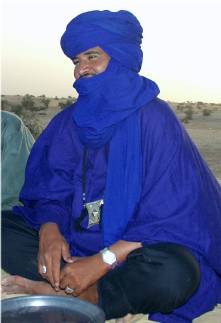 The Tuaregs are a desert people who have an independent and fierce
reputation.
A story that we heard repeated many times is that a severe drought in
1973
killed all of their livestock (camels, goats, sheep) which are an
absolute
necessity for life in the desert. At first many survived by
raiding
villages on the edge of the desert, but eventually most had to move
into
civilization in order to survive. Many have not been able to
leave
even yet, as the cost of replacing the livestock (a camel is $3-500
USD)
is a prohibitive expense. Halis assured us that he was only in
the
tour guide business in order to be able to get what he needed to be
able
to return to the life he loved. As he said, "I am Tuareg, I am
born
with the sand in my eyes" - although when spoken in French it is far
more
poetic sounding.
The Tuaregs are a desert people who have an independent and fierce
reputation.
A story that we heard repeated many times is that a severe drought in
1973
killed all of their livestock (camels, goats, sheep) which are an
absolute
necessity for life in the desert. At first many survived by
raiding
villages on the edge of the desert, but eventually most had to move
into
civilization in order to survive. Many have not been able to
leave
even yet, as the cost of replacing the livestock (a camel is $3-500
USD)
is a prohibitive expense. Halis assured us that he was only in
the
tour guide business in order to be able to get what he needed to be
able
to return to the life he loved. As he said, "I am Tuareg, I am
born
with the sand in my eyes" - although when spoken in French it is far
more
poetic sounding.
Our first stop was at the Sahara Passion Hotel ( spassion@bluewin.ch
)to drop off our stuff. This is the front gate and views of Timbuktu
from
the rooftop:
Below are views of one of the rooms (complete with mosquito net) and
the
shared bathroom at the end of the hall:
NOTE: I have received a number of comments about this website
since I have posted it. One of them was from Christine Rabah, who
has recently (early 2005) opened another hotel in Timbuktu. Her
website is well worth visiting: http://timbuktu-tombouctou.websiteanimal.com
Then Halis took us on a walking tour of the city which was very
interesting.
This is the Mosque at Timbuktu and an inside view:
We also stopped by the home of the Minister of Tourism for Timbuktu (it
was Saturday and the office was closed). He graciously
accomodated
us on his day off with the very important tourist ritual of stamping
our
passports with the Timbuktu stamp. We gave him something for his
trouble. On the right is a weaver in one of the markets:
Then it was time for our "Camel ride into the desert" - hardly a novel
activity as we saw other clusters of camels with tourists on them
making
the same trek.
But then came what surprisingly was a highlight of the Timbuktu part of
the trip - a stop in the desert. We dismounted and one of our
guides
brewed the Malian version of tea - a very strong concoction (think of
Cappucino
and cough syrup) served in small glasses. Definitely no shortage
of caffeine!
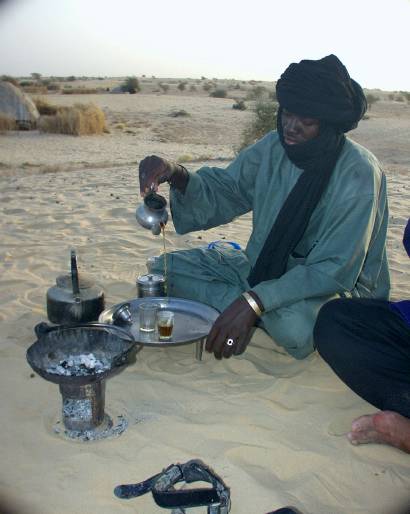 But what was really nice about this time was the quiet and peacefulness
of the desert. We could see why Halis preferred to live out here
away from the clamor of the city. Just the sound of the wind and
an occaisional grumble from a camel.
But what was really nice about this time was the quiet and peacefulness
of the desert. We could see why Halis preferred to live out here
away from the clamor of the city. Just the sound of the wind and
an occaisional grumble from a camel.
Well, that was until the phone rang! From somewhere deep
within
those blue robes Halis pulls out a cell phone! I nearly rolled on
the sand laughing...
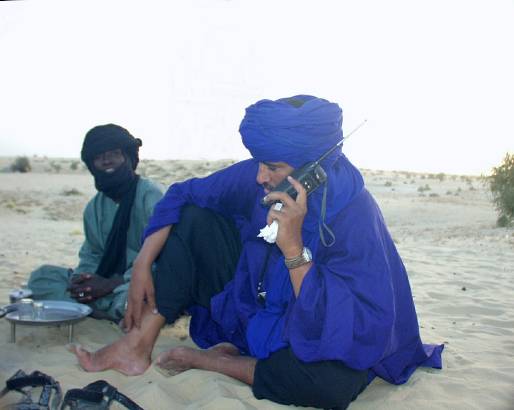 We rode back to Timbuktu as evening fell. One more important stop
was the Library at Timbuktu - possibly one of the oldest in the
world.
Many of the books in the collection have been passed down within
families
over many generations and have only recently been contributed for the
sake
of preservation. Some of the texts we saw were nearly a millenium
(or more) old.
We rode back to Timbuktu as evening fell. One more important stop
was the Library at Timbuktu - possibly one of the oldest in the
world.
Many of the books in the collection have been passed down within
families
over many generations and have only recently been contributed for the
sake
of preservation. Some of the texts we saw were nearly a millenium
(or more) old.
Next stop in the tour:
Djenne
Or you can skip to:
Home
Bamako
Mopti
Dogon Country
